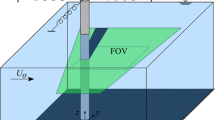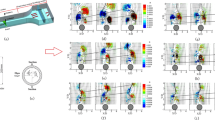Abstract
Three-dimensional vorticity in the wake of an inclined stationary circular cylinder was measured simultaneously using a multi-hot wire vorticity probe over a streamwise range of x/d = 10–40. The study aimed to examine the dependence of the wake characteristics on cylinder inclination angle α (=0°–45°). The validity of the independence principle (IP) for vortex shedding was also examined. It was found that the spanwise mean velocity \( \overline{W} , \) which represents the three-dimensionality of the wake flow, increases monotonically with α. The root-mean-square (rms) values of the streamwise (u) and spanwise (w) velocities and the three vorticity components decrease significantly with the increase of α, whereas the transverse velocity (v) does not follow the same trend. The vortex shedding frequency decreases with the increase of α. The Strouhal number (St N), obtained by using the velocity component normal to the cylinder axis, remains approximately a constant within the experimental uncertainty (±8%) when α is smaller than about 40°. The autocorrelation coefficients ρ u and ρ v of the u and v velocity signals show apparent periodicity for all inclination angles. With increasing α, ρ u and ρ v decrease and approach zero quickly. In contrast, the autocorrelation coefficient ρ w of w increases with α in the near wake, implying an enhanced three-dimensionality of the wake.














Similar content being viewed by others
References
Alam MM, Zhou Y (2007) Turbulent wake of an inclined cylinder with water running. J Fluid Mech 589:261–303
Antonia RA, Mi J (1998) Approach towards self-preservation of turbulent cylinder and screen wakes. Exp Therm Fluid Sci 17:277–284
Antonia RA, Zhou T, Zhu Y (1998) Three-component vorticity measurements in a turbulent grid flow. J Fluid Mech 374:29–57
Antonia RA, Zhou T, Romano GP (2002) Small-scale turbulence characteristics of two-dimensional bluff body wakes. J Fluid Mech 459:67–92
Blevins RD (2001) Flow-induced vibration. Krieger Publishing Company
Bloor MS (1964) The transition to turbulence in the wake of a circular cylinder. J Fluid Mech 19:290–309
Cavo A, Lemonis G, Panidis T, Paoailiou DD (2007) Performance of a 12-sensor vorticity probe in the near field of a rectangular turbulent jet. Exp Fluids 43:17–30
Chiba K, Horikawa A (1987) Numerical solution for the flow of viscoelastic fluids around an inclined circular cylinder. Rheologica Acta 26(3):243–254
Gulitski G, Kholmyansky M, Kinzelbach W, Lüthi B, Tsinober A, Yorish S (2007) Velocity and temperature derivatives in high-Reynolds-number turbulent flows in the atmospheric surface layer. Parts I. Facilities, methods and some general results. J Fluid Mech 589:57–81
Hanson AR (1966) Vortex shedding from yawed cylinders. AIAA J 4:738–740
Hoerner SF (1965) Fluid-dynamic drag. Practical information on aerodynamic drag and hydrodynamic resistance. Published by the author, pp 3–11
King R (1977a) Vortex excited oscillations of yawed circular cylinders. J Fluid Eng 99:495–502
King R (1977b) A review of vortex shedding research and its application. Ocean Eng 4:141–171
Kozakiewicz A, Fredse J, Sumer BM (1995) Forces on pipelines in oblique attack: steady current and waves. In: Proceedings of the fifth international offshore and polar engineering conference, The Hague, The Netherlands, The International Society of Offshore and Polar Engineers
Lucor D, Karniadakis GE (2003) Effects of oblique inflow in vortex-induced vibrations. Flow Turbulence Combustion 71:375–389
Marasli B, Nguyen P, Wallace JM (1993) A calibration technique for multiple-sensor hot-wire probes and its application to vorticity measurements in the wake of a circular cylinder. Exp Fluids 15:209–218
Marshall JS (2003) Wake dynamic of a yawed cylinder. J Fluid Eng 125:97–103
Matsumoto M, Shiraishi N, Shirato H (1992) Rain-wind induced vibration of cables of cable-stayed bridges. J Wind Eng Ind Aerodyn 43:2011–2022
Matsumoto M, Yagi T, Shigemura Y, Tsushima D (2001) Vortex-induced cable vibration of cable-stayed bridges at high reduced wind velocity. J Wind Eng Ind Aerodyn 89:633–647
Norberg C (2003) Fluctuating lift on a circular cylinder: review and new measurements. J Fluid Struct 17:57–96
Ramberg SE (1983) The effect of yaw and finite length upon the vortex wakes of stationary and vibrating circular cylinders. J Fluid Mech 128:81–107
Roshko A (1961) Experiments on the flow past a circular cylinder at very high Reynolds numbers. J Fluid Mech 10:345–356
Schlichting H (1979) Boundary-layer theory, 7th edn. McGraw-Hill, New York
Surry D, Surry J (1967) The effect of inclination on the Strouhal number and other wake properties of circular cylinders at subcritical Reynolds numbers. Technical Report, UTIAS Technical Institute for Aerospace Studies, University of Toronto
Tennekes H, Lumley JL (1972) A first course in turbulence. The MIT Press
Thakur A, Liu X, Marshall JS (2004) Wake flow of single and multiple yawed cylinders. J Fluid Eng 126:861–870
Tsinober A, Kit E, Dracos T (1992) Experimental investigation of the field of velocity gradients in turbulent flows. J Fluid Mech 242:169–192
Van Atta CW (1968) Experiments on vortex shedding from yawed circular cylinders. Technical Notes, pp 931–933
Wallace JM, Foss JF (1995) The measurement of vorticity in turbulent flows. Ann Rev Fluid Mech 27:469–514
Wang ZJ, Zhou Y, Huang JF, Xu YL (2005) Fluid dynamics around an inclined cylinder with running water rivulets. J Fluid Struct 21:49–64
Williamson CHK (1992) The natural and forced formation of spot-like ‘vortex dislocations’ in the transition of a wake. J Fluid Mech 243:393–441
Yiu MW, Zhou Y, Zhou T, Cheng L (2004) Reynolds number effects on 3-D vorticity in a turbulent wake. AIAA J 42(5):1009–1016
Zhao M, Cheng L, Zhou T (2008) Numerical simulation of three-dimensional flow past a yawed circular cylinder. J Fluid Struct (submitted)
Zhou Y, Antonia RA (1992) Convection velocity measurements in a cylinder wake. Exp Fluids 13:63–70
Zhou Y, Antonia RA (1995) Memory effects in a turbulent plane wake. Exp Fluids 19:112–120
Zhou T, Zhou Y, Yiu MW, Chua LP (2003) Three-dimensional vorticity in a turbulent cylinder wake. Exp Fluids 35:459–471
Acknowledgments
TZ would like to acknowledge the financial support from The University of Western Australia Research Grants Scheme.
Author information
Authors and Affiliations
Corresponding author
Rights and permissions
About this article
Cite this article
Zhou, T., Razali, S.F.M., Zhou, Y. et al. Dependence of the wake on inclination of a stationary cylinder. Exp Fluids 46, 1125–1138 (2009). https://doi.org/10.1007/s00348-009-0625-6
Received:
Revised:
Accepted:
Published:
Issue Date:
DOI: https://doi.org/10.1007/s00348-009-0625-6




